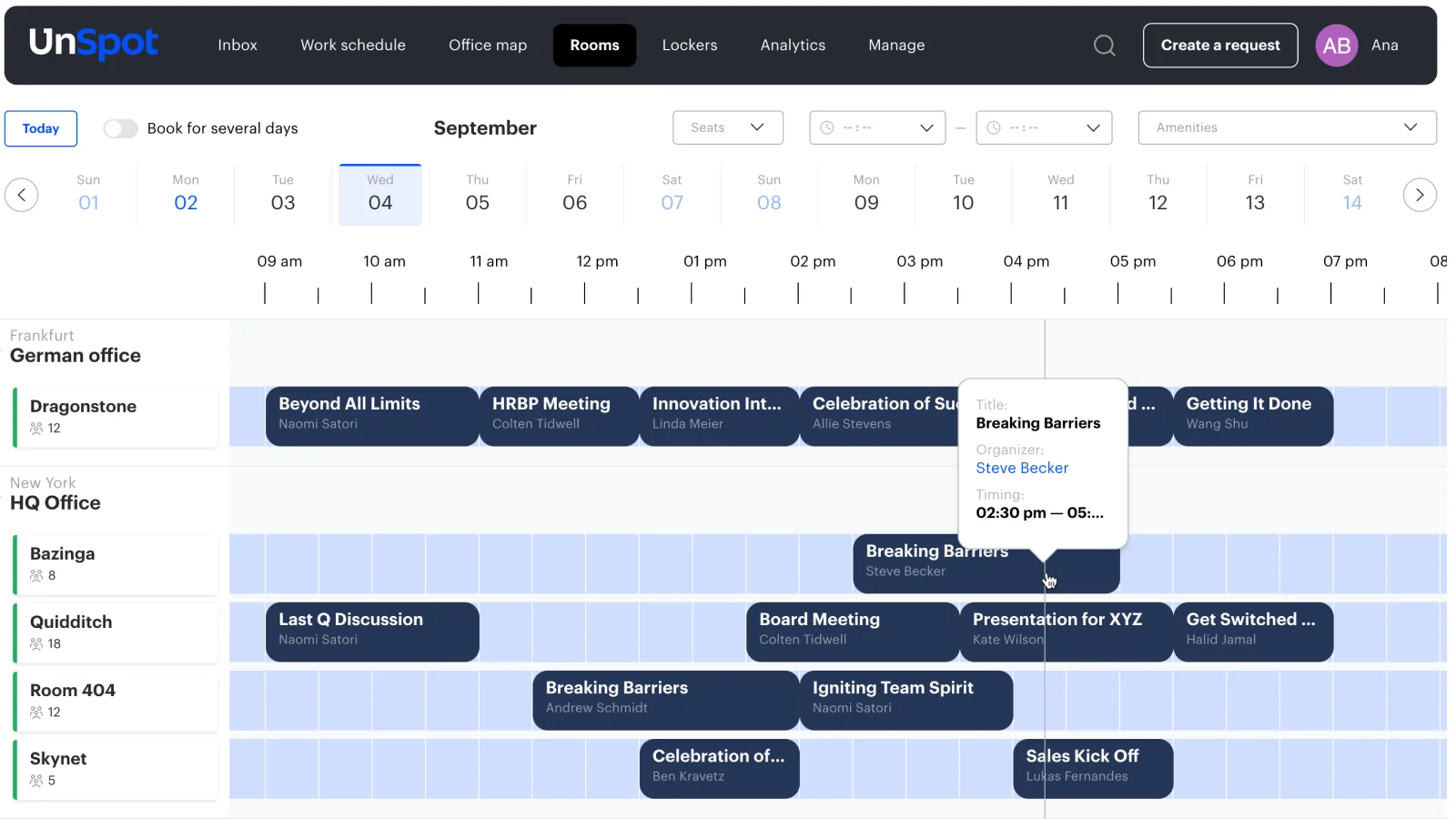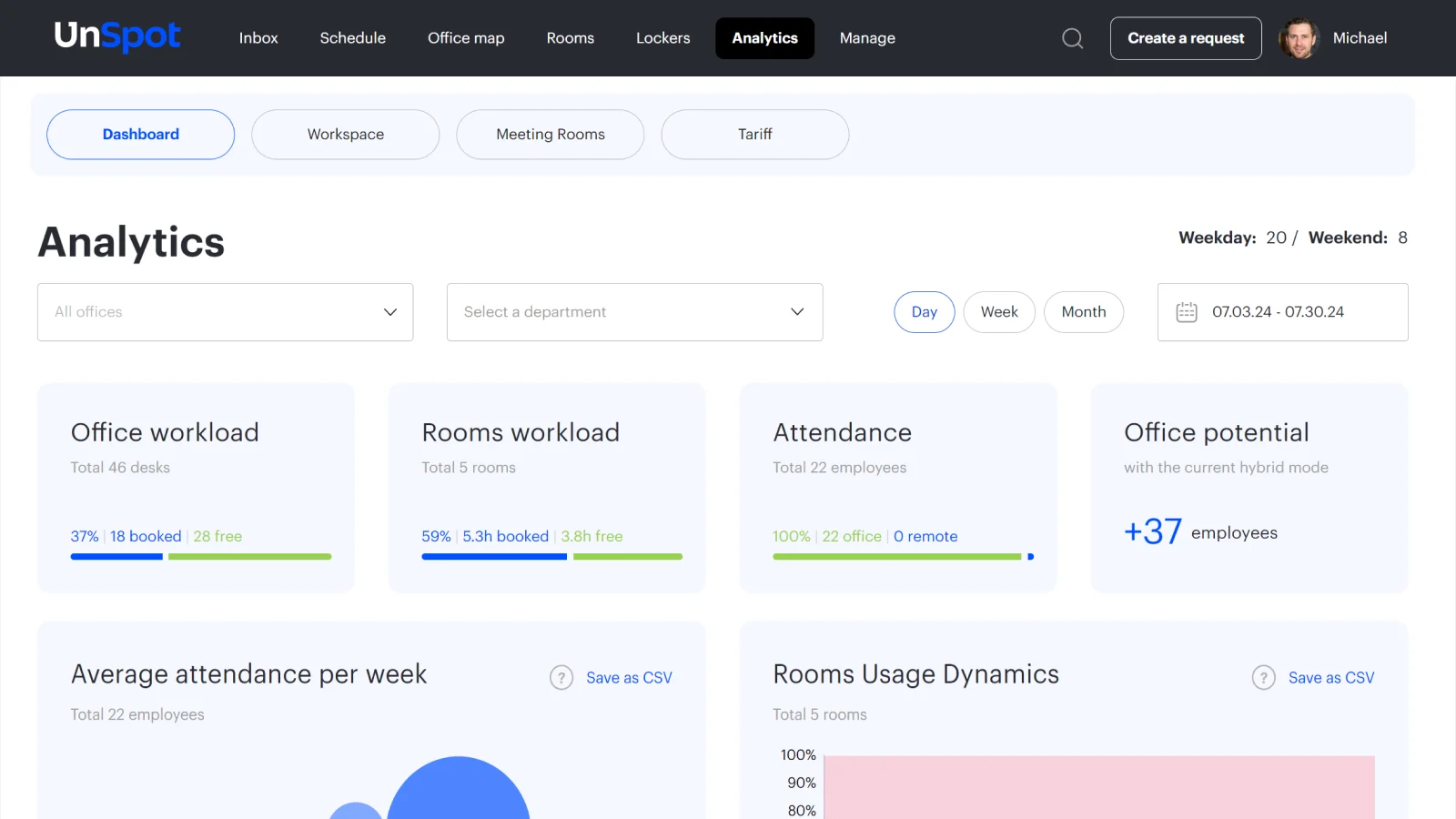Team meetings serve different purposes, like making decisions, brainstorming, sharing information, or offering guidance. They help your team connect and stay on track. But here’s the issue — only about half of meeting time is actually useful and engaging. We’re all familiar with pointless meetings that are not just frustrating but also waste time and money.
It’s time to rethink how to do meetings. Whether it’s a big company meeting or a quick daily check-in, meetings should be meaningful. We've put together a few simple tips you can hold meetings that energize your team and keep everyone focused and ready to move forward.
Basic Principles of Conducting More Effective Meetings
Regardless of the meeting’s nature, these elements should always be there:
Necessity. A meeting should be truly necessary, with clear consequences if it does not take place. It shouldn’t be held simply out of habit or to exercise control over the team.
Clarity of purpose. Objectives should be documented and communicated to all participants ahead of time.
Agenda. This provides a clear outline of topics to be covered and the order in which they will be addressed.
Need to attend. Participants should be selected based on their ability to contribute to the meeting’s goals. Each attendee’s role should be clear, and only those who can actively help achieve the meeting’s objectives should be invited.
Rapport. Meetings should foster a welcoming environment through basic courtesies and respect.
Recording. Accurate documentation involves taking notes that capture key decisions and actions, with the level of detail varying based on the meeting’s nature.
Timing. Meetings should follow a set time plan, with brief pauses to assess progress and make adjustments if necessary.
Continuous improvement. Get feedback on how the meeting went to see what worked and what could be better next time.
Contribution. All participants should have the opportunity to share their insights.
Openness and honesty. It’s important to deal with hidden agendas and make sure everyone communicates clearly to solve problems and have productive discussions.
👉 The Key to a Successful Meeting
But the true key to a successful meeting is structure. A well-organized meeting can turn an unproductive session into a valuable chance for progress and teamwork. Structure gives the meeting a clear framework and sets expectations, making sure time is used wisely.In a meeting without structure, conversations may stray off-topic, some people might dominate the discussion, or attendees might leave without clear action steps. So, maintain structure to make the meeting count.
Types of Meetings
Now that we have a clear understanding of what makes a meeting effective, let’s get into the various types of meetings commonly held in the business world. These include:
Traditional Meetings
In a traditional meeting, everyone gathers in a conference room, often dressed formally. Attendees sit around a table in a room, usually without specific seating assignments. Some people may have designated roles, like taking notes, leading the meeting, or guiding the discussion.
Daily Meetings
Daily meetings, also known as daily standups or check-ins, last 15-30 minutes. These are quick catch-ups, held in person or over the phone, that help teams stay aligned and review their work. It bridges the gap between larger, less frequent meetings.
Weekly Team Meetings
Weekly meetings are set times for teams or workgroups to come together. These sessions are used to share updates, talk about ongoing projects, address challenges and obstacles, ask questions, and plan for the week ahead.
Brainstorming Sessions
These sessions are all about coming up with fresh ideas. The goal is to innovate by working together to generate creative solutions. In brainstorming meetings, team members share ideas in a relaxed, informal setting. Everyone should have an equal chance to contribute.
SWOT Analysis Meetings
A SWOT analysis meeting brings together key team members to review the Strengths, Weaknesses, Opportunities, and Threats related to a project or initiative. The goal is to spot potential risks and issues early so they can be managed before they turn into bigger problems.
It’s a good idea to hold these SWOT meetings regularly — at least once every three months.
Round-Robin Meetings
A round robin is organized as an open forum where each person gets a set time to share their thoughts. The meeting follows a structured approach, with each participant taking their turn to speak in a specific order.
Workshops
Unlike regular business meetings, workshops require more preparation and usually last longer. They are led by a central trainer or facilitator who, along with a group of sponsors, plans the agenda, arranges collaborative activities, and ensures that the workshop achieves its goals. Workshops focus on hands-on participation and active involvement.
Hybrid Meetings
A hybrid meeting involves participants being in different locations. Some people attend the meeting in person, and others join via phone or online conference.
During hybrid meetings, it is important to provide a level playing field for all participants to actively participate in the discussion, regardless of their location. It can be challenging because you can’t always depend on everyone having the same technology or using physical tools like sticky notes. But they can be more manageable with the right hybrid work solution.
For a successful meeting, it is important to prepare and inform all participants in advance about the time, place and agenda of the meeting. For example, with modern meeting room booking and meeting management systems, you can easily select the right time and room, automatically notify all participants and calculate the optimal time based on different time zones. Such solutions save time and eliminate problems associated with meeting organization.

Open forum for employees
These are large meetings where management addresses all employees. In these sessions, everyone in the company comes together to discuss ideas, ask questions, and talk about important changes. These meetings help both employees and leaders connect, share their perspectives, and understand each other better.
Rules and Methods for Conducting Effective Meetings
Here are some tips for running meetings that will help you lead productive, successful sessions every time. These guidelines work well for different personalities and work styles.
Fishbone or Ishikawa Methods
This method helps identify and visualize the root causes of problems during a meeting with 6Ms: material, method/process, machine, measurement, manpower, and mother nature (environment).

The 5P Rule
To make your meetings more effective, follow the 5 P’s:
- Purpose. Clarify what your goals are before setting up the meeting.
- Preparation. Send out the agenda and any related materials before the meeting.
- Progress. Keep the meeting on track and note any additional issues for later.
- Participation. Encourage everyone to contribute and make sure all voices are heard.
- Process. Start and end on time. Follow the agenda, record key points, and clearly assign tasks.
The 5S Rule
For better meetings, you can also apply the 5S approach:
- Sort. Eliminate unnecessary topics and tasks. Focus only on what’s essential for the meeting's goals.
- Set in order. Organize your agenda, documents, and any tools or resources so they are easy to access and use during the meeting.
- Shine. Keep the meeting environment well-prepared. Check that all equipment works and materials are up-to-date.
- Standardize. Establish consistent procedures for meetings, like using regular agenda templates and setting clear roles.
- Sustain. Maintain improvements by regularly reviewing meeting practices.
The SMART Method
Set SMART goals to guide your meetings. SMART stands for Specific, Measurable, Achievable, Relevant, and Time-bound. This framework helps make your objectives clear, attainable, and meaningful.
For example, in the meeting, you could brainstorm and pick three possible solutions for a customer feedback issue using a voting system. You might also review the project’s current status, identify the main risks and opportunities for the next quarter, and assign tasks to each team member.
The RACI Method
A RACI meeting is a standard team meeting with a RACI matrix to guide task assignments. RACI stands for Responsible, Accountable, Consulted, and Informed. It helps bring structure to projects by outlining who does what, who oversees tasks, who needs to be consulted, and who should be kept updated.
While you don’t use the RACI chart during the meeting itself, it helps clarify roles and responsibilities beforehand.
The 10:10:10 Method
The 10:10:10 method helps you make better decisions by looking at their impact over different times:
- Think about how you’ll feel about the decision in just 10 minutes. This shows the immediate effects.
- Consider how you’ll feel about the decision in 10 months. This helps you see how it fits with your longer-term goals.
- Imagine how you’ll feel about the decision in 10 years. This guarantees the decision fits with your company’s principles and objectives.
Using this method in meetings helps you make choices that are good now and in the future.
Steps for Conducting an Effective Meeting: Preparation, Execution, Final
Preparation is the first phase and is essential for setting up a successful meeting. It involves defining clear goals, creating an agenda, and organizing materials. It lays the groundwork for a focused and organized team meeting.
The execution phase is where the meeting actually occurs. Here, the organizer needs to make sure the meeting stays on track and achieves its objectives, while also keeping participants engaged and productive.
The final phase is post-meeting actions, which involve sharing meeting notes and collecting feedback. This phase is key for making sure decisions are carried out, tasks are assigned, and future meetings are improved.
We'll talk more about each stage next ⬇️
Preparation Phase: How to Start Meeting
Making a strong first impression is important in business meetings, just like it is with introductions. If you’ve prepared well, learning how to do meetings should be easy.
Determine the Purpose and Have an Agenda
As the meeting organizer, you need to clarify the purpose and details. Ask yourself:
- Why is this meeting taking place?
- Who absolutely needs to be there, and what should they contribute?
- What are the main results you want to accomplish?
Clearly define these to set your meeting up for success and provide a plan to follow from beginning to end. Share the agenda with everyone involved, preferably a week before the meeting.
Choose the Best Time
Try scheduling meetings during natural breaks in people’s days — like after they’ve settled in the morning, before or after lunch, and so on. Also, add some buffer time between meetings. This will allow team members to finalize their tasks and gives extra time if discussions run over.
Assign Meeting Roles
For weekly team meetings or standups, assign different roles to team members and rotate them each time to build leadership skills. Here’s a quick rundown:
- Facilitator/moderator that manages the meeting;
- Timekeeper that monitors the clock and notifies the group if they’re running out of time for agenda items;
- Vibes watcher that helps manage participation and keeps an eye on comments or questions;
- Note-taker that records key points and decisions and distributes meeting notes and recordings.
Ask Participants to Prepare Questions
Ask everyone to think of any questions or topics they want to discuss. You might say, “Please come prepared with any questions or topics you’d like to cover. This will help us make the most of our time together.”

Make Sure to Prepare Mentally
Take some time to review the plan and key topics ahead of the meeting. Think about any potential questions or issues that might come up. Also, mentally rehearse any important points or decisions you need to make.
Prepare Technically
If you’re joining online, check your camera and microphone beforehand to make sure they’re working properly. Test your internet connection and make sure you’re familiar with any meeting software you'll be using.
For in-person meetings, inspect the room setup. Make sure any presentation equipment, like projectors or screens, is functioning correctly. Arrange seating so that everyone can see and hear clearly to facilitate good communication.
Prepare Visual Aids
If you're using presentations, check that your slides are well-organized and free of errors. Test the presentation on the equipment you’ll use to avoid any technical glitches.
For other materials, such as handouts or charts, make sure they are ready and easy to understand. Provide these materials to participants in advance if possible.
Confirm Meeting Location/Platform
For virtual meetings, confirm the platform details and see if the link or access code is correct. Test the platform beforehand to check that it’s working properly and that you’re familiar with its features.

Send Notifications to Participants
Send out reminders with key details such as the date, time, location, or virtual meeting link. You might say, “Just a reminder about our meeting tomorrow at 10:00 A.M. Here’s the agenda and the link to join the virtual session.”
📝 Main points about the preparatory phase
Start the meeting by defining its purpose and creating a clear agenda so that all participants know what to expect. Choose a convenient time to accommodate breaks throughout the day and leave some time between meetings for preparation. Assign roles such as moderator and timekeeper to maintain order and efficiency. Ask participants to prepare questions in advance to focus on important topics. Check technical equipment and send reminders to ensure everyone is ready for the meeting.
Execution Phase: What to Do During the Team Meeting
Once your team meeting begins, use your time wisely. What you do during it really makes a difference. In this section, we’ll cover tips and strategies to keep your meeting going well.
Arrive on Time
As the meeting leader, respect everyone’s time by beginning promptly. While some delays are unavoidable, plan for a short grace period and then move on with your agenda. No one enjoys waiting around and making small talk while the meeting gets started.
You might say something like, “Hi everyone, welcome! We’ll wait a minute or two for others to join and then get started.”
Greet Participants
In virtual meetings, it’s especially crucial to check that everyone’s microphones, audio, and cameras (if needed) are working properly. Do this while waiting for everyone to join.
You could say, “Can everyone hear me? I just shared my screen, so let me know if it’s not showing up.” If it’s a brainstorming session, try, “Let’s make sure everyone’s audio is working. Could everyone say their name so we can check that we can all hear each other?”
This gives team members a chance to fix any audio or camera issues before the meeting starts. Also, keep an eye on the “waiting room” or “lobby” of your video conference to admit anyone who might be waiting.
Follow the Agenda
After welcoming everyone, take a moment to review the meeting’s goals and plan. This shows you value their time and keeps the meeting focused. Also, go over any ground rules to keep things on track.
You might say, “Let’s start. Our goals today are to go over the three software options and decide which one to pick.”
Here are a few more tips:
- Write the agenda on a whiteboard or display it where everyone can see it.
- For longer meetings (30+ minutes), break down the agenda into time slots so everyone knows how long each topic will take.
- If the discussion goes off track, refer back to the agenda.
Manage Time Effectively
Stick to time references to manage meeting time better. A time reference is simply a set time next to each agenda item. For example, it could be a broad time frame, like 20 minutes, or a specific period, such as from 2:00 P.M. to 2:20 P.M. This way, you’ll know exactly when and how long to spend on each topic.
If you’re unsure, it’s better to allocate a bit more time than you think you’ll need, like giving 30 minutes for a task you estimate will take 15.
Engage Participants
Make meetings more engaging by adding some fun incentives, like giving an extra 15 minutes for lunch to someone who asks a great question. Encourage everyone to ask questions and share their ideas. Also, find out what the team wants from the meeting.
Address All Questions
When participants ask questions, answer them on the spot if possible. If a question requires more detailed research, acknowledge it and let everyone know you’ll follow up with an answer after the meeting.
Thank Participants and Close the Meeting
At the end of the meeting, take a moment to thank everyone for their time and contributions. You might say, “Thank you all for your contributions and involvement today. We’ve covered everything on the agenda and have clear next steps.” Next, recap the main points, decisions, and action items to make sure everyone is aligned.
Finally, let participants know what the next steps are and when they can expect any follow-up. For example, “I’ll send out the meeting notes later today, and we’ll reconvene next week to check on our progress.”
📝 Main points about the execution phase
During team meetings, it's crucial to use time wisely by starting promptly and greeting participants to ensure their equipment is working properly. Follow a clear agenda to maintain focus, manage time effectively by assigning specific time slots to each topic, and keep the meeting on track. Engage participants by encouraging questions and addressing them immediately or noting them for follow-up. Conclude the meeting by thanking everyone, summarizing key points, and outlining next steps to ensure everyone is aligned and aware of upcoming actions.
Final Phase: What to Do After the Meeting
After the meeting, it’s key to follow up properly. What you do next will help make sure everything discussed gets done.
Send Out Presentation and Notes
Summarize the main points in a document or email and send it to all attendees and anyone else who should be informed. Your summary should include:
- Key topics discussed;
- Action items with assigned team members and deadlines;
- Any issues or questions to address later.
Writing this up helps everyone understand what was decided and what the next steps are. It also provides a record to review in future meetings.
Collect and Process Feedback
Whether the meeting went well or not, get some feedback by sending out a survey or asking a few experienced team members for their thoughts. This isn’t about seeking praise but getting honest, constructive criticism.
Look into the details if you hear that the meeting wasn’t effective. Ask open-ended questions to understand the root cause without leading their responses.
Most importantly, act on the feedback! Ignoring it will make team members feel unvalued and discourage them from sharing their thoughts in the future.
Review and Address Mistakes in Future Meetings
Start by acknowledging any mistakes from past ones. Identify what went wrong, like miscommunication or missed tasks. In your next meeting, briefly talk about these issues and suggest improvements.
Then, put these changes into action and see if they help. Keep checking if the adjustments are working, and be open to further changes.
📝 Main points about the final phase
After a meeting, follow up by sending a summary of key topics, action items, and any outstanding questions to all relevant participants. Collect feedback through surveys to identify areas for improvement and act on it to enhance future meetings. Address any mistakes from past meetings by acknowledging them and implementing changes. Continuously assess the effectiveness of these adjustments and remain open to further improvements.
Common Meeting Mistakes and How to Avoid Them
Sometimes, meetings can use up a lot of time and resources without achieving much, which is frustrating and confusing for everyone involved. To avoid these problems, you should know what can go wrong in a good meeting and how to prevent it. Here are seven common pitfalls to be aware of ⬇️
Meetings Running Too Long
When meetings drag on or go off schedule, they tend to lead to tiredness and loss of interest. To avoid this, plan your meeting structure carefully and set specific time limits for each topic. Appoint someone as a timekeeper to help keep the meeting on track.
If discussions veer off-topic, consider saving those for a follow-up meeting or email instead. It’s better to cover fewer topics thoroughly instead of trying to address too many things.
Lack of Participant Questions
When participants don’t ask questions, it’s probably because they don’t feel there’s space for them.
To encourage questions, create an open environment where everyone feels comfortable speaking up. You can prompt participants by asking specific questions yourself or using tools like anonymous question submissions to help them voice their concerns.
Overly Formal Meetings Without Interaction
Meetings that don’t involve participants quickly become dull and disengaging.
To keep everyone interested, invite attendees to share their thoughts and feedback. Make the meeting more interactive by using methods like live polls, question boxes, or interactive activities. Be sure to recognize and address their input throughout the meeting.
No Moderation
What exactly is moderation? It involves guiding the discussion, managing time, addressing disruptions, and keeping the conversation focused. If there is no meeting lead, productivity tends to go down.
The solution is simple: have someone make certain that the formal discussion follows the rules and happens without problems.
Lack of a Presentation
This refers to the absence of a visual or structured guide, like slides or handouts, that organizes and communicates the key points of a meeting. Without it, discussions can become scattered, and participants may struggle to follow along or grasp important information.
Try to prepare something for participants to lock eyes on. It helps keep them engaged, and it also makes it easier for the presenter to stick to the intended structure.
Failure to Summarize Meeting Outcomes
Without a clear summary, people might leave with different ideas about what was decided. In the end, it can lead to inconsistent actions.
To avoid this, always recap the main points, decisions, and next steps at the end of the meeting. Share this recap with everyone quickly so that everyone understands what needs to be done.
Inconsistent Meeting Frequency
With hybrid work and changing employee schedules, many companies face the challenge of inconsistent meeting frequency. When teams work in different modes — some in the office and others remotely — it becomes more difficult to schedule regular meetings. Inconsistent meetings can lead to a loss of communication between team members and reduced productivity.
To make meetings clearer and avoid booking conflicts, office management systems can be used. These systems can track available rooms with the right equipment and instantly book them for the right time. And if something changes in the schedule of colleagues, the system will send a notification about the rescheduling of the meeting and help to find a new time and place.
Another feature of office management systems is analytical tools to track the frequency and duration of meetings, as well as the efficiency of their implementation. This helps to better manage team time and improve meeting productivity.

In addition, such a system will help to analyze the potential of the office as a whole and will tell you how many more employees you can accommodate with the current format of work.
5 Tips to Motivate Your Team for Productivity
Tip #1. Create a friendly atmosphere at the meeting
Start by welcoming everyone warmly and thanking them for their time. Encourage everyone to speak up and share their ideas. Use praise to acknowledge good contributions and keep the meeting organized to ensure a good mood.
Tip #2 Do your best to resolve conflicts in an environmentally friendly way
If conflicts happen to arise during a meeting, address them calmly and quickly. Listen to each person’s point of view without interrupting. Stay neutral and focused on solving the problem, and use strategies like compromise to reach a solution that works for everyone.
Tip #3. Adapt meetings for all participants, including virtual teams
For remote meetings, use a reliable video conferencing tool with features like screen sharing and chat. Send clear instructions before the meeting to avoid technical issues. Get everyone involved by using interactive tools.
Tip #4. Avoid unnecessary meetings to avoid taking up other people's time
Before scheduling a meeting, ask if you can achieve the same goals with an email or document. Think about whether the meeting will really help or if it’s just a routine check-in. Make sure the people you invite are essential to the discussion.
Tip #5. Come up with strategies to help minimize stress and fatigue during long meetings
To make long meetings easier, take regular breaks so people can rest. Involve everyone by switching speaking roles or adding interactive elements to keep things interesting.
For in-person meetings, provide snacks and drinks. For remote meetings, suggest having refreshments available and taking breaks as needed.
Checklist for Conducting an Effective Meeting
Before meeting
- Clearly outline why the meeting is happening and what you aim to achieve
- Set the meeting at a time that suits everyone
- Decide who will lead the meeting, take notes, and handle other tasks
- Request participants to prepare questions or topics they want to discuss beforehand
- Get ready by reviewing the agenda and key points
- Ensure all technical aspects, like video conferencing tools or presentations, are set up and tested
- Create any slides or handouts needed to support the meeting
- Double-check where the meeting will take place or which online platform will be used
- Inform participants about the meeting details
During meeting
- Start the meeting promptly to respect everyone’s time
- Welcome everyone and set a positive tone
- Stick to the plan to keep the meeting focused
- Make sure each topic gets enough time and keep the meeting on track
- Encourage participation from all attendees
- Answer questions as they come up and clarify any doubts
- Appreciate everyone’s contributions and close the meeting on a good note
After meeting
- Distribute any presentation materials and meeting notes if needed
- Ask participants for their thoughts on how the meeting went
- Identify what worked well and what didn’t, and use this feedback to make future meetings better
- Meetings often feel like a drain when they don’t tap into your team’s ideas or skills, and distractions creep in easily. But by checking off these key steps, you can transform meetings from a chore into something your team genuinely looks forward to. When you get these right, your meetings go from “meh” to “let’s go!”





